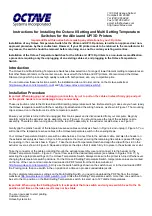
imageRUNNER ADVANCE 8500 and 8500 II Series Customer Expectations Document
Version 7 imageRUNNER ADVANCE 8500 and 8500 II Series Customer Expectations Document
Page 27
•
Encryption and Authentication
– SSL (Secure Sockets Layer) protects data
transferred over the network by encrypting file names and formats. The System
Administrator can also add IPSec capabilities to secure Internet Protocol (IP)
communications from lower layer protocols, such as TCP (Transmission
Control Protocol) and UDP (User Datagram Protocol) by authenticating and
encrypting each IP packet of a data stream across the Internet.
Additionally, the imageRUNNER ADVANCE 8500 and 8500 II Series supports
IEEE 802.1X, which provides port-based authentication. Authentication involves
communications between a supplicant, authenticator, and authentication server.
The supplicant is authentication software on a client device. The client device
(the imageRUNNER ADVANCE 8500 and 8500 II Series) needs the supplicant
to provide credentials, such as user names/passwords or digital certificates, to
the authenticator (a wireless access point). The authenticator then forwards the
credentials to the authentication server (generally a RADIUS database) for
verification. If the credentials are valid in the authentication server database,
the client device is allowed to access resources located on the protected side of
the network.
•
Network Port and Application Access Control
– Network Port and
Application Access Control enables system administrators to set up only the
necessary protocols, such as IPP, FTP, SNTP, SNMP, RAW, LPD, and others
for transferring data. These protocols can be switched on and off. The
administrator can also disable unneeded services, protocols, ports, and the
potential paths of attack so that attacks on the machine can be minimized.
•
SIEM (Security Information and Event Management) Integration
–
imageRUNNER ADVANCE devices using UFP 3.8 or later can be configured to
automatically send audit logs to SIEM systems for analysis and detection of
security violations. Examples of the audit logs sent via the Syslog protocol
(RFC5424, RFC5426) include those for user authentication, mail box operation,
network authentication, and print jobs. Sending audit logs via TLS encryption
(RFC5425) is supported.
















































